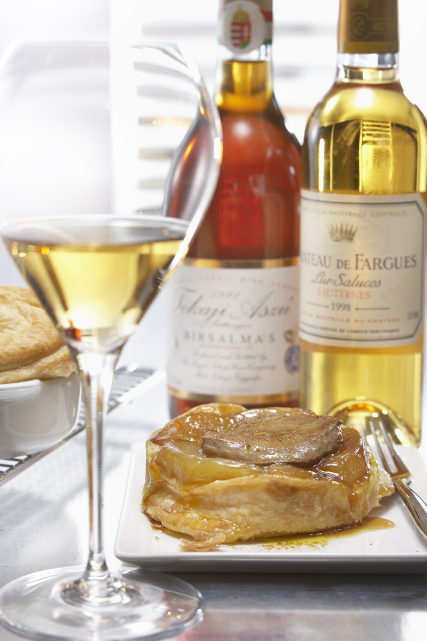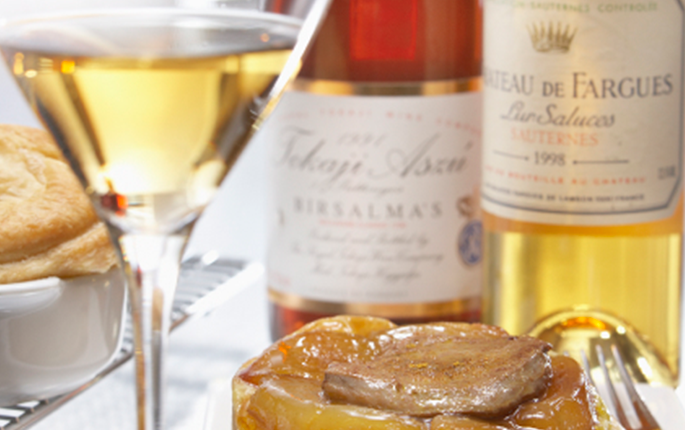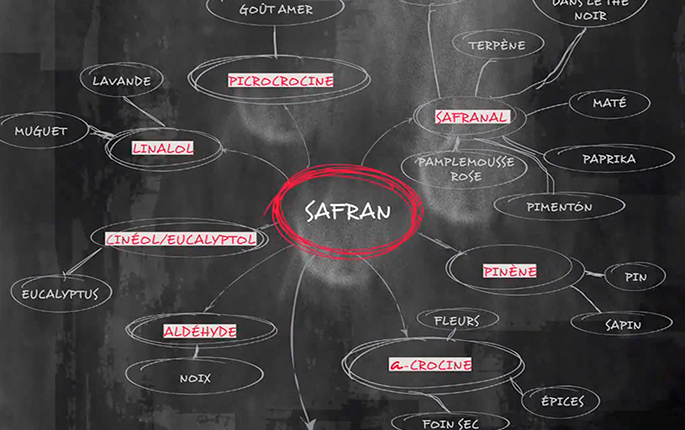SCIENCE
MOLECULAR HARMONIES

THE AROMATIC SCIENCE OF MOLECULAR HARMONIES EXPLAINED IN:
« 333 SECONDES »
With the principle of “Molecular harmonies”, the result is greater than the sum of the parts: 1 + 1 = 3!
A new mathematics of taste…
When combining ingredients dominated by the same family of aromatic molecules, the result obtained is greater than the sum of the parts:
1 + 1 = 3!
In practice, the principle of “Molecular harmonies” is as simple as choosing to cook a dish of red beets with Thai basil because the same molecule (eugenol) dominates both ingredients. You will be able to achieve perfect harmony thanks to the “aromatic synergy” of this dominant molecule found in both central components of the dish.
Then, if you serve a Tempranillo wine aged in oak barrels with this beet/Thai basil dish, a comparable “aromatic synergy” will occur between the dish and the wine. This harmony occurs because the eugenol molecule also dominates this type of red wine. You will thus obtain a perfect balance of food and wine!
This aromatic science provides a new understanding of the significant impact of aroma (aromatic molecules) in cooking. The science demonstrates that the dominant molecules of ingredients are at the very heart of the success of most recipes from the world’s gastronomic heritage. A 2011 study published in the specialized publications Nature and Scientific American, explained this new understanding of flavour science, and corroborating the thesis of François Chartier. The paper described the impact of François Chartier’s book Papilles et Molécules (published in 2009 and also published in English: Taste Buds and Molecules ), explaining that it opened new avenues of culinary creativity. Chartier’s book, at last, provides a scientific look at the foundations of food, wine and beverage pairings based on this new aromatic science while detailing why the resulting harmonies work so well.

François Chartier’s scientific research, undertaken in the late 1990s, is the result of nearly thirty years of intensive research and experimentation as a sommelier. At the same time, he conducted an exhaustive study of the world’s cuisines, and read extensively on food, wine, and wine science. Chartier’s research has finally shed light on the impact of aromas in our food, in other words, in our lives!
To use a musical metaphor, it is exactly the same as when playing a chord (a set of notes) by assembling notes of the same tonality. The resulting sound is beautiful to the ear. The chord is said to be tonal.
However, if the notes of the chord do not go together, the music is not so beautiful, becoming somewhat atonal.
The phenomenon is identical to the principle of molecular harmonies introduced by François Chartier in the early 2000s. When ingredients and liquids which share the same family of dominant aromas are cooked or harmonized (or played as notes in music), the effect is beautiful and, therefore, delicious. Through aromatic synergy, the result is always greater than the sum of the parts. The flavour is magnified, increased, multiplied. The phenomenon is like a sound enhanced when three notes are played together, as opposed to each note played in turn.
Chartier first began publishing the results of his research in the daily newspaper La Presse, where he wrote a weekly column from 2002 to 2013. But the real cornerstone dates to 2009, with the publication of Papilles et Molécules – La science aromatique des aliments et des vins, the first of seven books he has published to date (between 2009 and 2019). Papilles et Molécules won the prestigious title Best Cookbook in the World (Innovation Category), at the 2010 Gourmand World Cookbook Awards in Paris, which is the equivalent of the Oscars for gourmet books.
To better understand this gastronomic science, take the example of cloves. Among the several hundred aromatic molecules that make it up, only one dominates and thus signs its aromatic profile. In a way, this is its aromatic DNA. This molecule called eugenol is also found in Thai basil, red beets and cooked mozzarella, as well as in wines aged in oak barrels, particularly those from Spain made from the Tempranillo grape variety and the Ribera del Duero, Toro and Rioja appellations.
So, if you cook a dish using red beets and Thai basil or cloves, you obtain the desired “aromatic synergy” effect, and achieve a perfect harmony of flavours; the flavour generated by this duo (or trio) of foods with dominant molecules of the same family is magnified. And if you serve a wine aged in oak barrels, this “aromatic synergy” between the food and the wine will also be present. The harmony between food and wine will be successful and will lead you into a zone of perfect harmonic comfort.
Remember, 1 + 1 = 3!
The new “Mathematics of Taste “
It is a mistake to think that the perfume of a spice or herb is composed of a single aromatic molecule that gives it its specific character. On the contrary, the aroma of each herb and spice contains a cocktail of aromatic organic molecules. When mixed, they provide a unique aromatic signature, a kind of aromatic DNA.
On the other hand, certain aromatic compounds (molecules) may dominate others, both in quantity and potency. Eugenol for cloves or cinnamic aldehyde for cinnamon are two good examples. The dominant character trait in cinnamon is easy to identify, and then to match with other ingredients or liquids that have the same aromatic compound to achieve new harmonies between foods, and between foods and liquids.
When two foods or liquids sharing one or more dominant aromatic molecules come together, the result is greater than the sum of the parts. One plus one is no longer two, but three, or sometimes even four! Thanks to this aromatic science, we are witnessing a “new mathematics of taste!”
Scientific support for the thesis of “Molecular harmonies”
As early as 2004, even before the publication of Papilles et Molécules, François Chartier received several vital endorsements from the scientific community. The support came first from Quebecers Richard Béliveau Ph. D. (an oncology researcher and author of several books, including the global best-seller Foods that Fight Cancer) and Martin Loignon Ph. D. (Ph.D. in molecular biology and author of several texts in Chartier’s books). Then, Bordeaux oenologist Pascal Chatonnet (owner of Laboratoires Excell and author of two doctoral thesis on the impact of aromas in wines) endorsed Chartier’s work. All three have embraced Chartier’s aromatic theory and collaborated with him to make it a reality.
Soon after the publication of Papilles et Molécules, prestigious scientific magazines took an interest in this initiative, including Nature, in its Scientific Reports section, in 2011, and American Scientific, in 2013. After exhaustive studies and research, both reached the same results as François Chartier’s thesis on molecular harmony. They demonstrated scientifically that more than 80 % of ingredients used intuitively in Western recipes share the same family of dominant aromatic molecules. It is because of the aromatic synergy taking place between these ingredients that we instinctively bring them together in a recipe.
Why, for example, do Lebanese women choose parsley and mint for their tabbouleh (a couscous salad flavoured with parsley and mint), rather than parsley and rosemary or mint and thyme? There has never been a lack of choice since Lebanon is known as the herb garden of the Mediterranean. Intuitively, even unconsciously, these cooks were guided by their noses. They applied the aromatic synergy resulting from the combination of two ingredients from the same aromatic family with an aniseed profile, as outlined in Papilles et Molécules.
This encounter of mint and parsley illustrates that 1 + 1 does not equal 2, but instead 3, and perhaps even 4, as the final result is far superior (and better) than the combination of parsley and rosemary or mint and thyme. The new “mathematics of taste,” that of food combinations, was born under the nose of Lebanese women, a story of culinary traditions explained by science. Fascinating!
The instigator of a new scientific understanding
In 2002, Chartier was the first to explore, find and publish content concerning the aromatic harmony between foods or between foods and wines and other liquids. This science, which he called “molecular harmonies,” affects both culinary creation and the balance between wines (and other drinks) and food. Aromatic harmony between foods comes from the sharing of dominant aromatic molecules of the same family. The same is true for wines and other liquids that share dominant aromatic molecules with the food in the recipes that accompany them.
Since 2010, LaSalle College in Montreal has included 75 hours of molecular sommelier training based on Papilles et Molécules in its sommelier program. This book and L’Essentiel de Chartier (published in 2015) are used for sommellerie and culinary training by teachers and put into practice by many chefs and sommeliers around the world.
This discovery led to the creation of recipes with the collaboration of several chefs, including the renowned Ferran Adrià, from the mythical elBulli restaurant (recognized five times as the best restaurant in the world). Between 2007 and 2010, Chartier collaborated with Ferran Adrià on the development of some sixty dishes, all inspired by his scientific theory, which is based on the power of aromatic synergy between foods dominated by aromatic molecules of the same family.
In Quebec, the “créateur d’harmonies” has elaborated more than 1000 recipes in collaboration with Stéphane Modat, now chef of the Fairmont Le Château Frontenac restaurants. Together, they authored the books Les recettes de Papilles et Molécules (2010) and Papilles pour tous! (2012), 800 aromatic recipes in four volumes which won the prestigious prize for Best Wine and Food Pairing Book in the World at the Gourmand World Cookbook Awards 2012 in Paris. Chef Modat and Chartier also created and co-hosted the culinary series Papilles, broadcast on Télé-Québec in 2012 and on TV5 Monde in 125 French-speaking countries. Chef Modat also collaborated in creating a large part of the recipes for the book L’Essentiel de Chartier (2016).
Based on this aromatic theory, Chartier has created numerous tasting menus for several restaurants and events, with the collaboration of prestigious chefs such as Joan Roca, Andoni Aduriz, Carles Tejedor, Oriol Castro, Eduard Xatruch, Ferran Adrià, Normand Laprise, Jérôme Ferrer, Patrice Demers, Marc-André Jetté, Juni Ikematsu, Simon Mathys and, of course, Stéphane Modat. Chartier is often called upon to share his science at workshops and conferences, speaking to chefs, sommeliers, scientists and the general public at major food and wine fairs around the world.
3 SECONDES
The aromatic science of molecular harmonies explained in “3 seconds”
33 SECONDES
The aromatic science of molecular harmonies explained in “33 secondes”
Genesis
In order to understand the chemical reactions that govern the harmony of wines and food, it was necessary to have a scientific understanding of the molecular structure of food. After three years of misty reflections, from 2003 to 2006, a new research path imposed itself. I named it “harmonies and sommellerie moléculaires™”.



